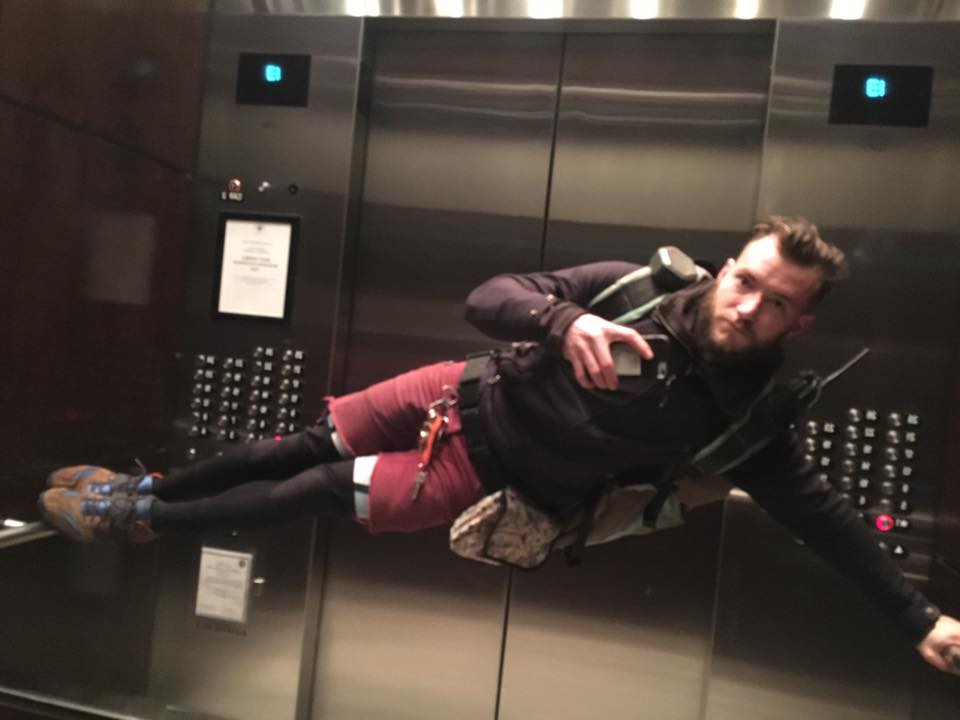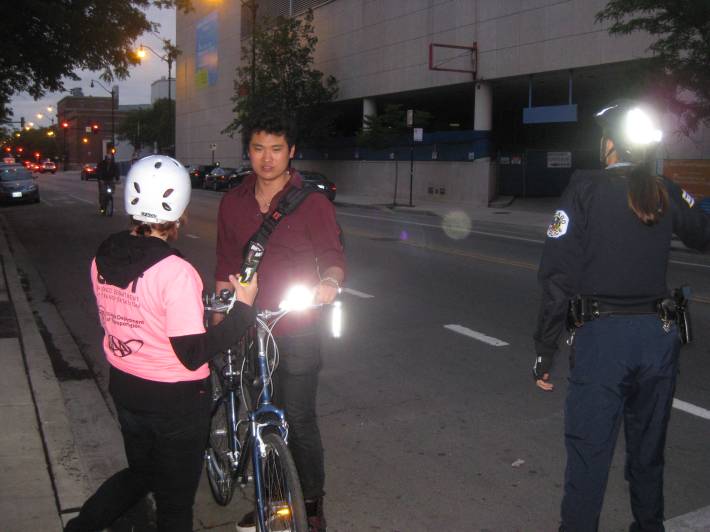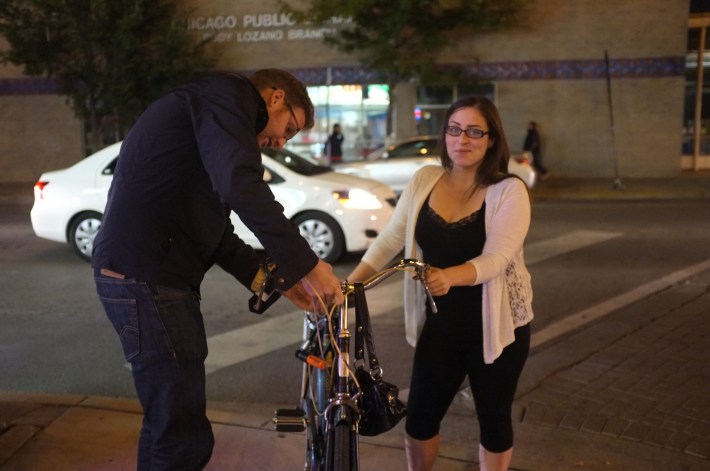Interview With the Ninja: Thoughts on Bike Light Enforcement
6:30 PM CST on January 23, 2018

Jonathan Loïc Rogers. Photo: Facebook
Update 1/24/18, 2 PM: From the comments, it's clear that some readers have mistaken this article as an endorsement of riding at night without lights. On the contrary, as the interviewee acknowledges, all cyclists are safer when they use bike lights at night. Rather, the purpose of this piece is to get inside the head of a bike ninja, so as to get a better idea of why some Chicagoans are choosing to ride without lights. This information can help inform outreach and/or enforcement strategies with the goal of ending this dangerous practice.
Last night around 11:30 p.m., food courier Jonathan Loïc Rogers was biking home to Humboldt Park when he heard a siren and saw flashing blue lights behind him near the relatively secluded Grand/Damen intersection in West Town. A pair of police officers in a squad car pulled him over because he didn’t a white front headlight, nor a red taillight or reflector, as required by state law, as well as Chicago city ordinance.
Rogers was wearing a jacket and tights with reflective piping, and his courier bag also had reflective elements. But technically he was a “bike ninja,” as defined by the Urban Dictionary: “someone who is riding their bicycle in dark/low visibility conditions, without a headlight or taillight.”
The officers wrote Rogers a ticker for the following ordinance:
9-52-080. Head lamps, reflectors and brakes.(a) Every bicycle when in use at nighttime shall be equipped with a head lamp which shall emit a white light visible from a minimum distance of 500 feet from the front and with a rear red reflector capable of reflecting the head lamp beams of an approaching motor vehicle back to the operator of such vehicle at distances up to 200 feet or a rear lamp emitting a red light visible from a distance of at least 200 feet from the rear.(b) Every bicycle shall be equipped with a brake that will enable the operator to make the braked wheel skid on dry, level, clean pavement.
The ticket states that Rogers’ offense was the lack of “headlights, reflectors, and brakes.” The courier says the brakes part is perverse because he was riding a single-speed cyclocross bike with disc brakes, which are very effective for stopping a cycle, even in wet conditions. He thinks the officer may have mistaken his bike for a single-speed fixed-gear cycle with no hand brakes, since his bike doesn’t have brake calipers above the wheels. (It’s worth noting that competent riders can also skid to a stop on a fixie with no hand brakes.)
All the same, Rogers acknowledges that he deserved a ticket for riding without illumination, and he’d be safer if he rode with lights. So why is he a bike ninja?
“Bike lights are expensive and I’ve had too many of them stolen,” Rogers says. Couldn’t he clip lights onto his bag or its strap? “I used to have one on my bag, but it would turn on when I put the bag down and I wouldn’t notice, so it would lose its charge.”
Rogers adds that he already has a few other gadgets that have to be kept charged for work, so lights would be another thing to plug in. (Nowadays many bike lights are USB rechargeable, rather than battery-powered.) “My bag and my clothes are reflective, and I ride defensively,” he says. “It’s a question of spending $50 for a ticket or $80 for lights.” Chicago Department of Transportation spokesman Mike Claffey indicated that the fine for biking at night without lights varies according to the administrative law judge who rules on the ticket.

Rogers says he’s ambivalent about bike light enforcement. “I agree that [bike lights] are a good safety measure for everyone, including myself,” he says. “But it did seem like the cops hadn’t seen any action for a while and were like, ‘Let’s pull him over.’”
A courier colleague of Rogers’ with whom I discussed his case spoke more negatively about the situation, arguing that ticketing for lack of bike lights is a waste of police resources, especially since he’s heard many stories of officers taking an eternity to show up to the scene of car-bike crashes. Moreover, he argued that ticketing for small-time offenses can be an excuse for police to harass cyclists. As the Chicago Tribune’s Mary Wisniewski reported last March, the vast majority of Chicago bike tickets are written in Black and Latino communities, possibly due to officers using the infractions like sidewalk riding an excuse to stop and frisk residents.
My opinion? Organized stings on bicyclists, such as the crackdown that took place at the North/Damen/Milwaukee intersection in Wicker Park a year ago, are, in fact, a waste of police time. That’s especially true when officers are ticketing for harmless moves like “Idaho stops,” cyclists treating stoplights like stop signs, while ignoring dangerous maneuvers by motorists, which was reportedly the case during the Wicker Park sting.
Ticketing cyclists without lights makes more sense, because it’s likely that some serious crashes could be prevented if more bike riders used illumination. And one approach that seems constructive is holding enforcement events where police partner with CDOT’s Bicycle Ambassadors outreach team at cycling hotspots like the aforementioned six-way intersection. When a bike ninja approaches, an officer flags them down and informs them they can either receive a ticket or let the ambassador install a free bike light on their handlebars.
That strikes me as an appropriate use of policing, one that actually helps improve public safety. Moreover, the risk of the stop going sour and escalating into a dangerous situation for the cyclist is minimized by the presence of the ambassadors, most of whom are people of color. That’s important in a city whose police force has well-documented issues with civil rights abuses.
Last summer the ambassadors conducted 20 bike light distribution events, all of them involving police, handing out lights to 1,275 residents, according to Claffey. Not every event involved stopping bike ninjas on the street. For example, CDOT and the CPD coordinated some events with BUILD, an Austin-based anti-violence organization, with 15th District officers attending.

It’s also worth noting that police aren’t necessarily needed to do this kind of safety outreach. In 2012 Streetsblog Chicago’s Steven Vance raised money for bike lights, with help from the bike-focused firm FK Law (an SBC sponsor). Vance paid the Active Transportation Alliance to organize volunteers to distribute the lights in locations like the 18th/Loomis/Blue Island intersection in Pilsen. The campaign was cheekily called “Get Lit.”
In addition to editing Streetsblog Chicago, John writes about transportation and other topics for additional local publications. A Chicagoan since 1989, he enjoys exploring the city on foot, bike, bus, and 'L' train.
Stay in touch
Sign up for our free newsletter
More from Streetsblog Chicago
They can drive 25: At committee meeting residents, panelist support lowering Chicago’s default speed limit
While there's no ordinance yet, the next steps are to draft one, take a committee vote and, if it passes, put it before the full City Council.
One agency to rule them all: Advocates are cautiously optimistic about proposed bill to combine the 4 Chicago area transit bureaus
The Active Transportation Alliance, Commuters Take Action, and Equiticity weigh in on the proposed legislation.



